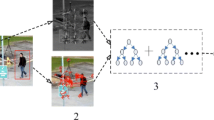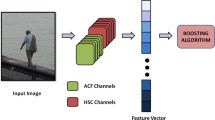Abstract
Pedestrian identification is a very important topic in the area of intelligent surveillance and public safety, where the near front face images of pedestrian can hardly be obtained due to high installation angle of camera, long-distance location and extreme light variations. This paper presents a new action-based pedestrian identification algorithm, which adopts hierarchical matching pursuit (HMP) to extract features and order preserving sparse coding (OPSC) to do classification. Two-layer HMP features are extracted from foreground frame image patches by sparse coding, max pooling and normalization, which preserve both local and global information. OPSC is taken as classifier to take full advantage of the spatial structure information, which is different from traditional temporal OPSC algorithm. The spatiotemporal order preserving sparse coding-based classification is also investigated. The effectiveness of the proposed method is verified on public data sets, and the experimental results show the superiority of our method.






Similar content being viewed by others
References
Aharon M. K-SVD: an algorithm for designing overcomplete dictionaries for sparse representation. IEEE Trans Signal Process. 2006;54(11):4311–22.
Blank M, Gorelick L, Shechtman E, Irani M, Basri R. Actions as space-time shapes. IEEE Trans Pattern Anal Mach Intell. 2005;29(12):1395–402.
Bo L, Ren X, Fox D. Hierarchical matching pursuit for image classification: architecture and fast algorithms. In: Advances in neural information processing systems (NIPS); 2011. p. 2115–2123.
Bo L, Ren X, Fox D. Unsupervised feature learning for RGB-D based object recognition. In: International symposium on experimental robotics (ISER); 2012. p. 387–402.
Bo L, Ren X, Fox D. Multipath sparse coding using hierarchical matching pursuit. In: 2013 IEEE conference on computer vision and pattern recognition (CVPR), Portland, OR, USA, June 23–28; 2013. p. 660–667.
Boulgouris NV, Hatzinakos D, Plataniotis KN. Gait recognition: a challenging signal processing technology for biometric identification. IEEE Signal Process Mag. 2005;22(6):78–90.
Cadieu C, Olshausen BA. Learning transformational invariants from natural movies. In: Advances in neural information processing systems (NIPS); 2009. p. 209–216.
Gkalelis N, Tefas A, Pitas I. Human identification from human movements. In: Proceedings of the international conference on image processing (ICIP), 7–10 November 2009. Egypt: Cairo; 2009. p. 2585–2588.
Kale A, Sundaresan A, Rajagopalan AN, Cuntoor NP, Roy-Chowdhury AK, Krger V, Chellappa R. Identification of humans using gait. IEEE Trans Image Process. 2004;13(9):1163–73.
Lu J, Tan Y. Gait-based human age estimation. IEEE Trans Inf Forensics Secur. 2010a;5(4):761–70.
Lu J, Tan Y. Uncorrelated discriminant simplex analysis for view-invariant gait signal computing. Pattern Recogn Lett. 2010b;31(5):382–93.
Lu J, Zhang E. Gait recognition for human identification based on ICA and fuzzy SVM through multiple views fusion. Pattern Recogn Lett. 2007;28(16):2401–11.
Lu J, Hu J, Zhou X, Shang Y. Activity-based person identification using sparse coding and discriminative metric learning. In: Proceedings of the 20th ACM multimedia conference, MM’12, Nara, Japan; October 29–November 02, 2012. p. 1061–1064.
Ni B, Moulin P, Yan S. Order-preserving sparse coding for sequence classification. In: Computer vision—ECCV 2012–12th european conference on computer vision, Florence, Italy, October 7–13, 2012. Part II: Proceedings; 2012. p. 173–87.
Ni B, Moulin P, Yan S. Order preserving sparse coding. IEEE Trans Pattern Anal Mach Intell. 2015;37(8):1615–28.
Piccardi M. Background subtraction techniques: a review. Systems, man and cybernetics. In: IEEE international conference on, IEEE, vol 4.; 2004. p. 3099–104.
Sarkar S, Phillips PJ, Liu Z, Vega IR, Grother P, Bowyer KW. The humanID gait challenge problem: data sets, performance, and analysis. IEEE Trans Pattern Anal Mach Intell. 2005;27(2):162–77.
Wang L, Tan T, Ning H, Hu W. Silhouette analysis-based gait recognition for human identification. IEEE Trans Pattern Anal Mach Intell. 2004;25(12):1505–18.
Yuan X, Liu X, Yan S. Visual classification with multi-task joint sparse representation. In: IEEE computer society conference on computer vision and pattern recognition (CVPR); 2010. p. 3493–3500.
Yuan X, Liu X, Yan S. Visual classification with multitask joint sparse representation. IEEE Trans Image Process. 2012;21(10):4349–60.
Acknowledgments
This work was supported in part by the National High Technology Research and Development Program (863 Program) of China under Grant 2014AA012204, in part by the National Natural Science Foundation of China under Grant 61202228 and Grant 61472002.
Author information
Authors and Affiliations
Corresponding author
Ethics declarations
Conflict of Interest
Si-Bao Chen, Yi Xin and Bin Luo declare that they have no conflict of interest
Informed Consent
All procedures followed were in accordance with the ethical standards of the responsible committee on human experimentation (institutional and national) and with the Helsinki Declaration of 1975, as revised in 2008 (5). Additional informed consent was obtained from all patients for which identifying information is included in this article.
Human and Animal Rights
This article does not contain any studies with human participants or animals performed by any of the authors.
Rights and permissions
About this article
Cite this article
Chen, SB., Xin, Y. & Luo, B. Action-Based Pedestrian Identification via Hierarchical Matching Pursuit and Order Preserving Sparse Coding. Cogn Comput 8, 797–805 (2016). https://doi.org/10.1007/s12559-016-9393-9
Received:
Accepted:
Published:
Issue Date:
DOI: https://doi.org/10.1007/s12559-016-9393-9




